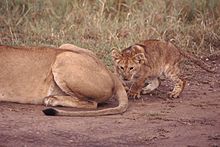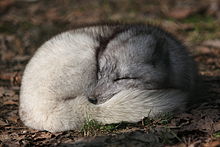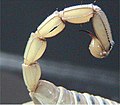Tail

The tail is the section at the rear end of an animal's body; in general, the term refers to a distinct, flexible appendage to the torso. It is the part of the body that corresponds roughly to the sacrum and coccyx in mammals, reptiles, and birds. While tails are primarily a feature of vertebrates, some invertebrates including scorpions and springtails, as well as snails and slugs, have tail-like appendages that are sometimes referred to as tails. Tailed objects are sometimes referred to as "caudate" and the part of the body associated with or proximal to the tail are given the adjective "caudal".
Function

Animal tails are used in a variety of ways. They provide a source of locomotion for fish and some other forms of marine life.[1] Many land animals use their tails to brush away flies and other biting insects.[2] Some species, including cats and kangaroos, use their tails for balance;[3][4] and some, such as New World monkeys and opossums, have what are known as prehensile tails, which are adapted to allow them to grasp tree branches.[5]
Tails are also used for social signaling. Some deer species flash the white underside of their tails to warn other nearby deer of possible danger,[6] beavers slap the water with their tails to indicate danger,[7] and canids (including domestic dogs) indicate emotions through the positioning and movement of their tails.[8] Some species' tails are armored, and some, such as those of scorpions, contain venom.[9]
Some species of lizard can detach ("cast") their tails from their bodies. This can help them to escape predators, which are either distracted by the wriggling, detached tail or left with only the tail while the lizard flees. Tails cast in this manner generally grow back over time, though the replacement is typically darker in colour than the original.[10]
Most birds' tails end in long feathers called rectrices. These feathers are used as a rudder, helping the bird steer and maneuver in flight;[11] they also help the bird to balance while it is perched.[12] In some species—such as birds of paradise, lyrebirds, and most notably peafowl—modified tail feathers play an important role in courtship displays.[13] The extra-stiff tail feathers of other species, including woodpeckers and woodcreepers, allow them to brace themselves firmly against tree trunks.[14]
The tails of grazing animals, such as horses, are used both to sweep away insects and positioned or moved in ways that indicate the animal's physical or emotional state.[15]
Human tails
Human embryos have a tail that measures about one-sixth of the size of the embryo itself.[16] As the embryo develops into a fetus, the tail is absorbed by the growing body. Infrequently, a child is born with a ’"soft tail", which contains no vertebrae, but only blood vessels, muscles, and nerves, but this is regarded as an abnormality rather than a vestigial true tail, even when such an appendage is located where the tail would be expected.[17][18]
Humans have a "tail bone" (the coccyx) attached to the pelvis, formed of fused vertebrae, usually four, at the bottom of the vertebral column. It does not protrude externally.
Gallery
-
Pig (Sus domestica)
-
Glyptodon (Glyptodon asper)
-
Longhorn cowfish (Lactoria cornuta)
-
Grévy's zebra (Equus grevyi)
-
American alligator (Alligator mississipiensis)
-
Hippopotamus (Hippopotamus amphibius)
See also
- Rump (animal)
- Empennage, the tail of an aircraft
References
- ^ Robert W. Blake (26 May 1983). Fish Locomotion. CUP Archive. p. 143. ISBN 978-0-521-24303-2.
- ^ Gilbert WALDBAUER; Gilbert Waldbauer (30 June 2009). What Good Are Bugs? Insects in the Web of Life. Harvard University Press. p. 253. ISBN 978-0-674-04474-6.
- ^ Outwitting Cats: Tips, Tricks and Techniques for Persuading the Felines in Your Life That What You Want Is Also What They Want. Rowman & Littlefield. p. 21. ISBN 978-1-59921-625-6.
- ^ Byron Dawson (2003). The Heinemann Science Scheme. Heinemann. p. 125. ISBN 978-0-435-58332-3.
- ^ Melissa Stewart (1 January 2007). New World Monkeys. Lerner Publications. p. 11. ISBN 978-0-8225-6765-3.
- ^ D. Muller-Schwarze (6 December 2012). Chemical Signals: Vertebrates and Aquatic Invertebrates. Springer Science & Business Media. p. 47. ISBN 978-1-4684-1027-3.
- ^ Bruce M. Carlson (14 October 2008). Beneath the Surface: A Natural History of a Fisherman's Lake. Minnesota Historical Society. p. 240. ISBN 978-0-87351-656-3.
- ^ Stanley Coren; Sarah Hodgson (15 February 2011). Understanding Your Dog For Dummies. John Wiley & Sons. p. 250. ISBN 978-1-118-05276-1.
- ^ Adele Richardson (1 July 2002). Scorpions. Capstone. p. 20. ISBN 978-0-7368-1318-1.
- ^ Stephen J. Divers; Douglas R. Mader (13 December 2005). Reptile Medicine and Surgery. Elsevier Health Sciences. p. 3468. ISBN 1-4160-6477-X.
- ^ ANNA BOTSFORD COMSTOCK (8 January 2010). HANDBOOK OF NATURE STUDY. Lulu.com. p. 34. ISBN 978-1-4092-2794-6.
- ^ David Burnie (5 May 2008). DK Eyewitness Books: Bird. DK Publishing. p. 19. ISBN 978-0-7566-6758-0.
- ^ Exploring Life Science. Marshall Cavendish. 2000. p. 731. ISBN 978-0-7614-7145-5.
- ^ Robert W. McFarlane (1994). A Stillness in the Pines: The Ecology of the Red-cockaded Woodpecker. Norton. p. 40. ISBN 978-0-393-31167-9.
- ^ Mary Pope Osborne; Natalie Pope Boyce (28 October 2014). Magic Tree House Fact & Fiction: Horses. Random House Children's Books. p. 113. ISBN 978-0-553-52368-3.
- ^ "Human fetuses have tails, proving that evolution is true". The Free Lance-Star. July 5, 2005. Retrieved 2009-04-28.
{{cite news}}: Cite has empty unknown parameter:|coauthors=(help) - ^ "Human tail–caudal appendage: tethered cord". Nature. February 1, 2008. Retrieved 2009-04-28.
{{cite news}}: Cite has empty unknown parameter:|coauthors=(help) - ^ "The 'human tail' causing tethered cervical cord". Nature (journal). November 14, 2006. Retrieved 2009-04-28.
{{cite news}}: Cite has empty unknown parameter:|coauthors=(help)







